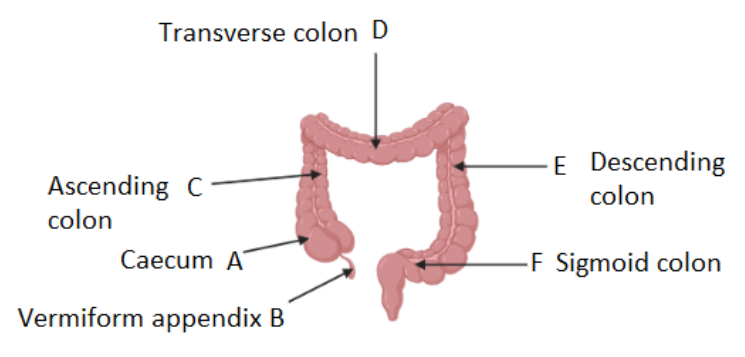
The diagram of the large intestine of a man is given below. Identify the parts labeled A, B, C, D, E, and F.

I. A- Sigmoid colon, B- Vermiform appendix, C- Ascending colon, D- Transverse colon, E- Descending colon, F- Caecum.
II. A- Caecum, B- Vermiform appendix, C- Sigmoid colon, D- Ascending colon, E- Transverse colon, F- Descending colon
III. A- Caecum, B- Vermiform appendix, C- Ascending colon, D- Transverse colon, E- Descending colon, F- Sigmoid colon
IV. A- Sigmoid colon, B- Vermiform appendix, C- Descending colon, D- Transverse colon, E- Ascending colon, F- Caecum

Answer
552k+ views
Hint: Large intestine is a part of the alimentary canal or human digestive system. It is also called the largest bowel. The large intestine forms the last part of the human digestive system. The main function of the large intestine is to absorb the water and store the waste material which is later expelled out as feces.
Complete answer: Human digestive system consists of organs such as the mouth, pharynx, esophagus, stomach, small intestine, large intestine, and anus. The large intestine is the last part of the digestive system where reabsorption of water takes place against the osmotic gradient in the intestines. This is called standing gradient osmosis. The large intestine is just below the waist and begins in the right iliac region of the pelvis, where it is joined at the caecum to the end of the small intestine. In the given diagram, A represents the caecum which is the beginning of the large intestine. The caecum is a pouch-like shape and elongates to form the vermiform appendix. The vermiform appendix is labeled as B in the diagram. The caecum is involved in the process of digestion and is the first section of the colon. The colon of the large intestine is divided into four sections. They are named ascending colon, transverse colon, descending colon, and sigmoid colon. They are represented by labels C, D, E, and F respectively in the above-given diagram.

So, option I is the correct option.
Note: Vermiform appendix which is developed embryonically from the caecum is not involved in the digestion process. The vitamins secreted by the colonic bacteria such as vitamin K are absorbed by the colon. Another important function of the large intestine is that it stores the waste matter in the rectum until it is expelled out through the anus as feces.
Complete answer: Human digestive system consists of organs such as the mouth, pharynx, esophagus, stomach, small intestine, large intestine, and anus. The large intestine is the last part of the digestive system where reabsorption of water takes place against the osmotic gradient in the intestines. This is called standing gradient osmosis. The large intestine is just below the waist and begins in the right iliac region of the pelvis, where it is joined at the caecum to the end of the small intestine. In the given diagram, A represents the caecum which is the beginning of the large intestine. The caecum is a pouch-like shape and elongates to form the vermiform appendix. The vermiform appendix is labeled as B in the diagram. The caecum is involved in the process of digestion and is the first section of the colon. The colon of the large intestine is divided into four sections. They are named ascending colon, transverse colon, descending colon, and sigmoid colon. They are represented by labels C, D, E, and F respectively in the above-given diagram.

So, option I is the correct option.
Note: Vermiform appendix which is developed embryonically from the caecum is not involved in the digestion process. The vitamins secreted by the colonic bacteria such as vitamin K are absorbed by the colon. Another important function of the large intestine is that it stores the waste matter in the rectum until it is expelled out through the anus as feces.
Recently Updated Pages
Master Class 11 Social Science: Engaging Questions & Answers for Success

Master Class 11 Physics: Engaging Questions & Answers for Success

Master Class 11 Maths: Engaging Questions & Answers for Success

Master Class 11 Economics: Engaging Questions & Answers for Success

Master Class 11 Computer Science: Engaging Questions & Answers for Success

Master Class 11 Chemistry: Engaging Questions & Answers for Success

Trending doubts
What is meant by exothermic and endothermic reactions class 11 chemistry CBSE

10 examples of friction in our daily life

One Metric ton is equal to kg A 10000 B 1000 C 100 class 11 physics CBSE

1 Quintal is equal to a 110 kg b 10 kg c 100kg d 1000 class 11 physics CBSE

Difference Between Prokaryotic Cells and Eukaryotic Cells

The camels hump is made of which tissues a Skeletal class 11 biology CBSE




